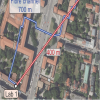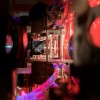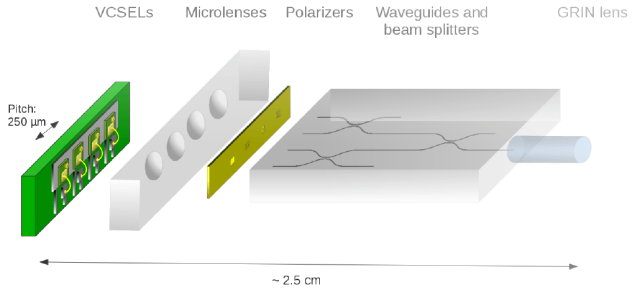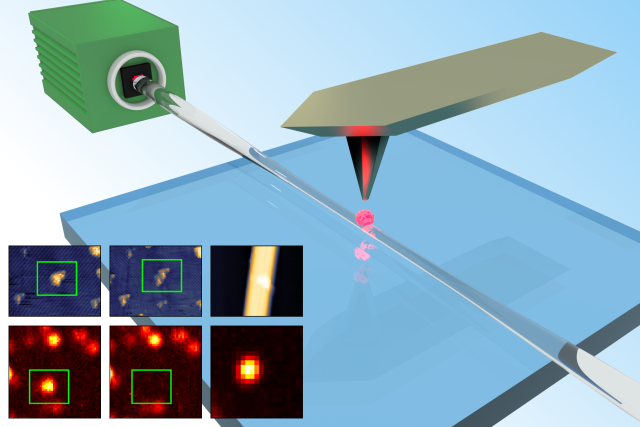
Long-Lived Quantum Memory Enabling Atom-Photon Entanglement over 101 km of Telecom Fiber
Y. Zhou, P. Malik, F. Fertig, M. Bock, T. Bauer, T. van Leent, W. Zhang, C. Becher, H. Weinfurter
Prx Quantum 5 (2), 14 (2024).
Long-distance entanglement distribution is the key task for quantum networks, enabling applications such as secure communication and distributed quantum computing. In this work, we take a crucial step toward this task by sharing entanglement over long optical fibers between a single 87Rb atom and a single photon. High fidelity of the atomic state could be maintained during long flight times through such fibers by prolonging the coherence time of the single atom to 10 ms based on encoding in long-lived states. In addition, the attenuation in the fibers is minimized by converting the wavelength of the photon to the telecom S band via polarization-preserving quantum frequency conversion. These improvements enable us to observe entanglement between the atomic quantum memory and the emitted photons transmitted through standard spooled telecom fibers with a length of 101 km with a fidelity of 70.8 +/- 2.4%. This fidelity is comparable to recent demonstrations over 20 km, despite the channel loss now significantly exceeding 20 dB. In fact, now the reduction in fidelity is due to detector dark counts rather than loss of coherence of the atom or photon, proving the suitability of our platform to realize city-to-city-scale quantum network links.

Comment on ""photons can tell 'contradictory' answer about where they have been""
G. Reznik, C. Versmold, J. Dziewior, F. Huber, H. Weinfurter, J. Dressel, L. Vaidman
European Physical Journal Plus 139 (2), 181 (2024).
"Yuan and Feng (Eur. Phys. J. Plus 138:70, 2023) recently proposed a modification of the nested Mach-Zehnder interferometer experiment performed by Danan et al. (Phys. Rev. Lett. 111:240402, 2013) and argued that photons give ""contradictory"" answers about where they have been, when traces are locally imprinted on them in different ways. They concluded that their results are comprehensible from what they call the ""three-path interference viewpoint,"" but difficult to explain from the ""discontinuous trajectory"" viewpoint advocated by Danan et al. We argue that the weak trace approach (the basis of the ""discontinuous trajectory"" viewpoint) provides a consistent explanation of the Yuan-Feng experiment. The contradictory messages of the photons are just another example of photons lying about where they have been when the experimental method of Danan et al. is applied in an inappropriate setup."

Valid and efficient entanglement verification with finite copies of a quantum state
P. Cieslinski, J. Dziewior, L. Knips, W. Klobus, J. Meinecke, T. Paterek, H. Weinfurter, W. Laskowski
Npj Quantum Information 10 (1), 14 (2024).
Detecting entanglement in multipartite quantum states is an inherently probabilistic process, typically with a few measured samples. The level of confidence in entanglement detection quantifies the scheme's validity via the probability that the signal comes from a separable state, offering a meaningful figure of merit for big datasets. Yet, with limited samples, avoiding experimental data misinterpretations requires considering not only the probabilities concerning separable states but also the probability that the signal came from an entangled state, i.e. the detection scheme's efficiency. We demonstrate this explicitly and apply a general method to optimize both the validity and the efficiency in small data sets providing examples using at most 20 state copies. The method is based on an analytical model of finite statistics effects on correlation functions which takes into account both a Frequentist as well as a Bayesian approach and is applicable to arbitrary entanglement witnesses.

Deep-learning-based radio-frequency side-channel attack on quantum key distribution
A. Baliuka, M. Stöcker, M. Auer, P. Freiwang, H. Weinfurter, L. Knips
Physical Review Applied 20 (5), 54040 (2023).
Quantum key distribution (QKD) protocols have been proven to be secure on the basis of fundamental physical laws,. however, the proofs consider a well-defined setting and encoding of the sent quantum signals only. Side channels, where the encoded quantum state is correlated with properties of other degrees of freedom of the quantum channel, allow an eavesdropper to obtain information unnoticeably, as demonstrated in a number of hacking attacks on the quantum channel. However, also classical radiation emitted by the devices may be correlated, leaking information on the potential key, especially when combined with novel data-analysis methods. We demonstrate here a side-channel attack using a deep convolutional neural network to analyze the recorded classical, radio-frequency electromagnetic emissions. Even at a distance of a few centimeters from the electronics of a QKD sender containing frequently used electronic components, we are able to recover virtually all information about the secret key. However, as shown here, countermeasures can enable a significant reduction of both the emissions and the amount of secretkey information leaked to the attacker. Our analysis methods are independent of the actual device and thus provide a starting point for assessing the presence of classical side channels in QKD devices.

Quantum networks with neutral atom processing nodes
J. P. Covey, H. Weinfurter, H. Bernien
Npj Quantum Information 9 (1), 90 (2023).
Quantum networks providing shared entanglement over a mesh of quantum nodes will revolutionize the field of quantum information science by offering novel applications in quantum computation, enhanced precision in networks of sensors and clocks, and efficient quantum communication over large distances. Recent experimental progress with individual neutral atoms demonstrates a high potential for implementing the crucial components of such networks. We highlight latest developments and near-term prospects on how arrays of individually controlled neutral atoms are suited for both efficient remote entanglement generation and large-scale quantum information processing, thereby providing the necessary features for sharing high-fidelity and error-corrected multi-qubit entangled states between the nodes. We describe both the functionality requirements and several examples for advanced, large-scale quantum networks composed of neutral atom processing nodes.

Photons are lying about where they have been, again
G. Reznik, C. Versmold, J. Dziewior, F. Huber, S. Bagchi, H. Weinfurter, J. Dressel, L. Vaidman
Physics Letters A 470, 128782 (2023).
Bhati and Arvind (2022) [5] recently argued that in a specially designed experiment the timing of photon detection events demonstrates photon presence at a location at which they are not present according to the weak value approach. The alleged contradiction is resolved by a subtle interference effect resulting in anomalous sensitivity of the signal imprinted on the postselected photons for the interaction at this location, similarly to the case of a nested Mach-Zehnder interferometer with a Dove prism (Alonso and Jordan (2015) [7]). We perform an in-depth analysis of the characterization of the presence of a pre-and postselected particle at a particular location based on information imprinted on the particle itself. The theoretical results are tested by a computer simulation of the proposed experiment.(c) 2023 Elsevier B.V. All rights reserved.

Advances in device-independent quantum key distribution
V. Zapatero, T. van Leent, R. Arnon-Friedman, W. Z. Liu, Q. Zhang, H. Weinfurter, M. Curty
Npj Quantum Information 9 (1), 10 (2023).
Device-independent quantum key distribution (DI-QKD) provides the gold standard for secure key exchange. Not only does it allow for information-theoretic security based on quantum mechanics, but it also relaxes the need to physically model the devices, thereby fundamentally ruling out many quantum hacking threats to which non-DI QKD systems are vulnerable. In practice though, DI-QKD is very challenging. It relies on the loophole-free violation of a Bell inequality, a task that requires high quality entanglement to be distributed between distant parties and close to perfect quantum measurements, which is hardly achievable with current technology. Notwithstanding, recent theoretical and experimental efforts have led to proof-of-principle DI-QKD implementations. In this article, we review the state-of-the-art of DI-QKD by highlighting its main theoretical and experimental achievements, discussing recent proof-of-principle demonstrations, and emphasizing the existing challenges in the field.

Quantum key Distribution with a Hand-Held Sender Unit
G. Vest, P. Freiwang, J. Luhn, T. Vogl, M. Rau, L. Knips, W. Rosenfeld, H. Weinfurter
Physical Review Applied 18 (2), 24067 (2022).
Quantum key distribution (QKD) is a crucial component for truly secure communication, which enables the leakage of information due to eavesdropper attacks to be analyzed. Although impressive progress was made in the field of long-distance implementations, user-oriented applications involving short-distance links have mostly remained overlooked. Recent technological advances in integrated photonics now enable developments towards QKD also for existing hand-held communication platforms. In this work we report on the design and evaluation of a hand-held free-space QKD system including a micro-optics-based sender unit. This system implements the BB84 protocol employing polarization-encoded faint laser pulses at a rate of 100 MHz. Unidirectional beam tracking and live reference-frame alignment systems at the receiver side enable a stable operation over tens of seconds when aiming the portable transmitter to the receiver input by hand from a distance of about half a meter. The user-friendliness of our system was confirmed by successful key exchanges performed by different untrained users with an average link efficiency of about 20% relative to the case of the transmitter being stationarily mounted and aligned. In these tests we achieve an average quantum bit error ratio (QBER) of 2.4% and asymptotic secret key rates ranging from 4.0 kbps to 15.3 kbps. Given its compactness, the versatile sender optics is also well suited for integration into other free-space communication systems enabling QKD over any distance.

A device-independent quantum key distribution system for distant users
W. Zhang, T. van Leent, K. Redeker, R. Garthoff, R. Schwonnek, F. Fertig, S. Eppelt, W. Rosenfeld, V. Scarani, C. C. W. Lim, H. Weinfurter
Nature 607 (7920), 687-691 (2022).
Device-independent quantum key distribution (DIQKD) enables the generation of secret keys over an untrusted channel using uncharacterized and potentially untrusted devices(1-9). The proper and secure functioning of the devices can be certified by a statistical test using a Bell inequality(10-12). This test originates from the foundations of quantum physics and also ensures robustness against implementation loopholes(13), thereby leaving only the integrity of the users' locations to be guaranteed by other means. The realization of DIQKD, however, is extremely challenging-mainly because it is difficult to establish high-quality entangled states between two remote locations with high detection efficiency. Here we present an experimental system that enables for DIQKD between two distant users. The experiment is based on the generation and analysis of event-ready entanglement between two independently trapped single rubidium atoms located in buildings 400 metre apart(14). By achieving an entanglement fidelity of F >= 0.892(23) and implementing a DIQKD protocol with random key basis(15), we observe a significant violation of a Bell inequality of S = 2.578(75)-above the classical limit of 2- and a quantum bit error rate of only 0.078(9). For the protocol, this results in a secret key rate of 0.07 bits per entanglement generation event in the asymptotic limit, and thus demonstrates the system's capability to generate secret keys. Our results of secure key exchange with potentially untrusted devices pave the way to the ultimate form of quantum secure communications in future quantum networks.

Entangling single atoms over 33 km telecom fibre
T. van Leent, M. Bock, F. Fertig, R. Garthoff, S. Eppelt, Y. R. Zhou, P. Malik, M. Seubert, T. Bauer, W. Rosenfeld, W. Zhang, C. Becher, H. Weinfurter
Nature 607 (7917), 69-+ (2022).
Quantum networks promise to provide the infrastructure for many disruptive applications, such as efficient long-distance quantum communication and distributed quantum computing(1,2). Central to these networks is the ability to distribute entanglement between distant nodes using photonic channels. Initially developed for quantum teleportation(3,4) and loophole-free tests of Bell's inequality(5,6) recently, entanglement distribution has also been achieved over telecom fibres and analysed retrospectively(7,8). Yet, to fully use entanglement over long-distance quantum network links it is mandatory to know it is available at the nodes before the entangled state decays. Here we demonstrate heralded entanglement between two independently trapped single rubidium atoms generated over fibre links with a length up to 33 km. For this, we generate atom-photon entanglement in two nodes located in buildings 400 m line-of-sight apart and to overcome high-attenuation losses in the fibres convert the photons to telecom wavelength using polarization-preserving quantum frequency conversion(9). The long fibres guide the photons to a Bell-state measurement setup in which a successful photonic projection measurement heralds the entanglement of the atoms(10). Our results show the feasibility of entanglement distribution over telecom fibre links useful, for example, for device-independent quantum key distribution(11-13) and quantum repeater protocols. The presented work represents an important step towards the realization of large-scale quantum network links.

A portable and compact decoy-state QKD sender
M. Auer, P. Freiwang, A. Baliuka, M. Schattauer, L. Knips, H. Weinfurter, Ieee
Conference on Lasers and Electro-Optics Europe / European Quantum Electronics Conference (CLEO/Europe-EQEC) (2021).

Event-Ready Entanglement of Distant Atoms Distributed at Telecom Wavelength
T. van Leent, F. Fertig, M. Bock, R. Garthoff, Y. R. Zhou, S. Eppelt, W. Zhang, C. Becher, H. Weinfurter, Ieee
Conference on Lasers and Electro-Optics Europe / European Quantum Electronics Conference (CLEO/Europe-EQEC) (2021).

Cooperation and dependencies in multipartite systems
W. Klobus, M. Miller, M. Pandit, R. Ganardi, L. Knips, J. Dziewior, J. Meinecke, H. Weinfurter, W. Laskowski, T. Paterek
New Journal of Physics 23 (6), 63057 (2021).
We propose an information-theoretic quantifier for the advantage gained from cooperation that captures the degree of dependency between subsystems of a global system. The quantifier is distinct from measures of multipartite correlations despite sharing many properties with them. It is directly computable for classical as well as quantum systems and reduces to comparing the respective conditional mutual information between any two subsystems. Exemplarily we show the benefits of using the new quantifier for symmetric quantum secret sharing. We also prove an inequality characterizing the lack of monotonicity of conditional mutual information under local operations and provide intuitive understanding for it. This underlines the distinction between the multipartite dependence measure introduced here and multipartite correlations.

Gaussian state entanglement witnessing through lossy compression
W. Klobus, P. Cieslinski, L. Knips, P. Kurzynski, W. Laskowski
Physical Review A 103 (3), 32412 (2021).
We study the possibility of witnessing Gaussian entanglement between two continuous-variable systems with the help of two spatially separated qubits. Its key ingredient is a local lossy state transfer from the original systems onto local qubits. The qubits are initially in a pure product state, therefore by detecting entanglement between the qubits we witness entanglement between the two original systems.

Extending Quantum Links: Modules for Fiber- and Memory-Based Quantum Repeaters
P. van Loock, W. Alt, C. Becher, O. Benson, H. Boche, C. Deppe, J. Eschner, S. Hofling, D. Meschede, P. Michler, F. Schmidt, H. Weinfurter
Advanced Quantum Technologies 3 (11), 1900141 Advanced Quantum Technologies, (2020).
Elementary building blocks for quantum repeaters based on fiber channels and memory stations are analyzed. Implementations are considered for three different physical platforms, for which suitable components are available: quantum dots, trapped atoms and ions, and color centers in diamond. The performances of basic quantum repeater links for these platforms are evaluated and compared, both for present-day, state-of-the-art experimental parameters as well as for parameters that can in principle be reached in the future. The ultimate goal is to experimentally explore regimes at intermediate distances-up to a few 100 km-in which the repeater-assisted secret key transmission rates exceed the maximal rate achievable via direct transmission. Two different protocols are considered, one of which is better adapted to the higher source clock rate and lower memory coherence time of the quantum dot platform, while the other circumvents the need of writing photonic quantum states into the memories in a heralded, nondestructive fashion. The elementary building blocks and protocols can be connected in a modular form to construct a quantum repeater system that is potentially scalable to large distances.

Multipartite entanglement analysis from random correlations
L. Knips, J. Dziewior, W. Klobus, W. Laskowski, T. Paterek, P. J. Shadbolt, H. Weinfurter, J. D. A. Meinecke
Npj Quantum Information 6 (1), 51 (2020).
Quantum entanglement is usually revealed via a well aligned, carefully chosen set of measurements. Yet, under a number of experimental conditions, for example in communication within multiparty quantum networks, noise along the channels or fluctuating orientations of reference frames may ruin the quality of the distributed states. Here, we show that even for strong fluctuations one can still gain detailed information about the state and its entanglement using random measurements. Correlations between all or subsets of the measurement outcomes and especially their distributions provide information about the entanglement structure of a state. We analytically derive an entanglement criterion for two-qubit states and provide strong numerical evidence for witnessing genuine multipartite entanglement of three and four qubits. Our methods take the purity of the states into account and are based on only the second moments of measured correlations. Extended features of this theory are demonstrated experimentally with four photonic qubits. As long as the rate of entanglement generation is sufficiently high compared to the speed of the fluctuations, this method overcomes any type and strength of localized unitary noise.

Long-Distance Distribution of Atom-Photon Entanglement at Telecom Wavelength
T. van Leent, M. Bock, R. Garthoff, K. Redeker, W. Zhang, T. Bauer, W. Rosenfeld, C. Becher, H. Weinfurter
Physical Review Letters 124 (1), 10510 (2020).
Entanglement between stationary quantum memories and photonic channels is the essential resource for future quantum networks. Together with entanglement distillation, it will enable efficient distribution of quantum states. We report on the generation and observation of entanglement between a Rb-87 atom and a photon at telecom wavelength transmitted through up to 20 km of optical fiber. For this purpose, we use polarization-preserving quantum frequency conversion to transform the wavelength of a photon entangled with the atomic spin state from 780 nm to the telecom S band at 1522 nm. We achieve an unprecedented external device conversion efficiency of 57% and observe an entanglement fidelity between the atom and telecom photon of >= 78.5 +/- 0.9% after transmission through 20 km of optical fiber, mainly limited by decoherence of the atomic state. This result is an important milestone on the road to distribute quantum information on a large scale.


